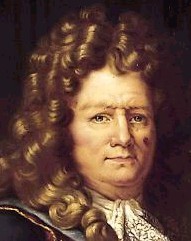| Profile | Major Works | Resources |
Sébastien le Prestre, Seigneur de Vauban, 1633-1707

French military engineer and early liberal.
Sébastien Vauban was a military engineer and a Maréchal in Louis XIV's army. His work on fortifications and siegecraft is legendary - some 160 locations are credited to Vauban. The Corps de Génie had been separated from the rest of the army in 1676, but it was Vauban who transformed the Corps into a well-trained and highly-professional school of engineers. The Corps eventually detached itself from its military roots (Vauban himself had embraced civil engineering projects, like the Languedoc canal) and eventually became institutionalized as the École des Ponts et Chaussées. Vauban can consequently be regarded as the grandfather of the French engineering tradition.
Although indispensable to Louis XIV, Vauban boldly stretched his goodwill on several occasions. In 1685, Vauban vocally condemned the repeal of the edict of Nantes (which led to the persecution of the French Protestants). Interestingly, his opposition was mostly made on economic grounds. In the 1690s, he conducted a comprehensive census of Flanders and other areas of France, which has earned him his nickname as the "French Petty". A prolific writer on many subjects, e.g. forestry, pig breeding, monetary policy, colonization, etc., Vauban was made an honorary member of the Academy of Sciences.
Dismayed by the inefficiency of Colbertisme, Vauban published his 1707 tract Projet d'une Dixme Royale (with his name on the title page and without the king's permission.) Vauban called for the repeal of all taxes (taille, etc.) and the imposition of a single direct tax of 10% on all income from land and trade, with no exemptions for the nobles or clergy. He backed up his argument with an impressive mass of statistics. In his vision, Vauban's 10% would not be a permanent rate, but rather a maximum, to be adjusted according to wartime exigency and general economic circumstances of the time, giving it a counter-cyclical character - by his estimate, it would average 6.6%, and be lowered to 3.3% for workers during economically depressed times. To maintain viability of overall finances, Vauban defended the introduction of some modest excise taxes on luxury items (wigs, swords, wine in taverns), etc.
The publication of Vauban's proposal was a scandalous affair - largely because Vauban did not shy away from severely criticizing the current royal administration and describing the realm as a whole as misgoverned. King Louis XIV took it as a personal affront, and Vauban fell into disgrace (he died shortly after). His contemporary, Boisguilbert, who put out a similar treatise at exactly the same time, was caught up in the Vauban maelstorm and proscribed.
Nonetheless, in 1710, the controller-general Desmarets used Vauban's arguments to justify for the imposition of a Dixième along Vauban's design - albeit in addition to, rather than instead of, existing taxes. The vigorous protest of the nobles and clergy eventually led to the sneaking in of exemptions, until it was entirely repealed in 1717. Justified as an emergency wartime tax, it was reimposed in 1733-36 to finance the war of Polish succession and 1741-49 for the war of Austrian succession. The latter was particularly knotty, as although hostilities had ended in 1748, war debts were massive, and the controller-general Machault d'Arnouville could not bring himself to repeal the Dixème,. To maintain the tax in peacetime and pay off war debts, Machault halved it to a 5% tax (the vingtième). Vigorously opposed, it led to the fall of Machault and cleared the way for the ascendancy of the Madame de Pompadour.
Vauban's work inspired many later Enlightenment economists, such as Forbonnais, Mirabeau and the Physiocrats.
|
Major Works of Sébastien de Vauban
|
|
Resources on Vauban
|
All rights reserved, Gonçalo L. Fonseca
